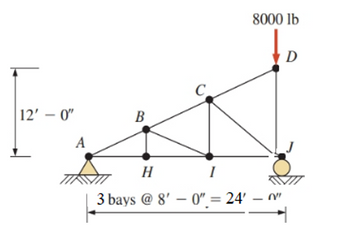
Structural Analysis
6th Edition
ISBN: 9781337630931
Author: KASSIMALI, Aslam.
Publisher: Cengage,
expand_more
expand_more
format_list_bulleted
Concept explainers
Question
thumb_up100%
- For the truss shown below identify zero force members. Make sure to state which joint you are looking at, which rules you are following and the zero force members. (When answering statement, start with "Looking @ joint... your case... are zero force members."

Transcribed Image Text:### Truss Analysis Diagram
**Description:**
This diagram represents a truss structure with labeled joints and members, typically used in civil engineering to analyze forces and load distributions. The diagram is used to visually depict how the forces are distributed throughout the structure.
**Key Components:**
- **Joints:**
- **A, B, C, D, H, I, J**: Points where the members of the truss connect.
- **Members:**
- **Truss Members**: Straight beams connecting the joints.
- **Supports:**
- **At A**: A triangular support indicates a pinned support allowing rotation but no translation.
- **At J**: A circular support represents a roller support allowing horizontal translation only.
- **Load:**
- **8000 lb at Point D**: A downward force applied at joint D.
- **Dimensions:**
- **Height (A to D)**: 12 feet.
- **Horizontal Length (A to J)**: Composed of 3 bays, each 8 feet long, totaling 24 feet.
- **Structural Layout:**
- The truss is supported on the left by a pinned support at A and on the right by a roller support at J, creating stability.
- The force of 8000 pounds applied at the top joint D causes stress to be distributed through the truss members to the supports.
This type of diagram is crucial for understanding the load distribution in structures such as bridges, roofs, and other frameworks, and aids in calculating forces and ensuring safety and stability.
Expert Solution
This question has been solved!
Explore an expertly crafted, step-by-step solution for a thorough understanding of key concepts.
This is a popular solution
Trending nowThis is a popular solution!
Step by stepSolved in 5 steps with 4 images

Knowledge Booster
Learn more about
Need a deep-dive on the concept behind this application? Look no further. Learn more about this topic, civil-engineering and related others by exploring similar questions and additional content below.Similar questions
- What is the reaction force at joint A and I. What is the C or T, the X and Y components, the length and the load of each member. Also when you put the answers could you put it like it is on the image.arrow_forwardAnswer question 8 the answer is provided by the second pic for referencearrow_forwardPlease answer complete questionarrow_forward
arrow_back_ios
arrow_forward_ios
Recommended textbooks for you

 Structural Analysis (10th Edition)Civil EngineeringISBN:9780134610672Author:Russell C. HibbelerPublisher:PEARSON
Structural Analysis (10th Edition)Civil EngineeringISBN:9780134610672Author:Russell C. HibbelerPublisher:PEARSON Principles of Foundation Engineering (MindTap Cou...Civil EngineeringISBN:9781337705028Author:Braja M. Das, Nagaratnam SivakuganPublisher:Cengage Learning
Principles of Foundation Engineering (MindTap Cou...Civil EngineeringISBN:9781337705028Author:Braja M. Das, Nagaratnam SivakuganPublisher:Cengage Learning Fundamentals of Structural AnalysisCivil EngineeringISBN:9780073398006Author:Kenneth M. Leet Emeritus, Chia-Ming Uang, Joel LanningPublisher:McGraw-Hill Education
Fundamentals of Structural AnalysisCivil EngineeringISBN:9780073398006Author:Kenneth M. Leet Emeritus, Chia-Ming Uang, Joel LanningPublisher:McGraw-Hill Education
 Traffic and Highway EngineeringCivil EngineeringISBN:9781305156241Author:Garber, Nicholas J.Publisher:Cengage Learning
Traffic and Highway EngineeringCivil EngineeringISBN:9781305156241Author:Garber, Nicholas J.Publisher:Cengage Learning


Structural Analysis (10th Edition)
Civil Engineering
ISBN:9780134610672
Author:Russell C. Hibbeler
Publisher:PEARSON

Principles of Foundation Engineering (MindTap Cou...
Civil Engineering
ISBN:9781337705028
Author:Braja M. Das, Nagaratnam Sivakugan
Publisher:Cengage Learning

Fundamentals of Structural Analysis
Civil Engineering
ISBN:9780073398006
Author:Kenneth M. Leet Emeritus, Chia-Ming Uang, Joel Lanning
Publisher:McGraw-Hill Education


Traffic and Highway Engineering
Civil Engineering
ISBN:9781305156241
Author:Garber, Nicholas J.
Publisher:Cengage Learning